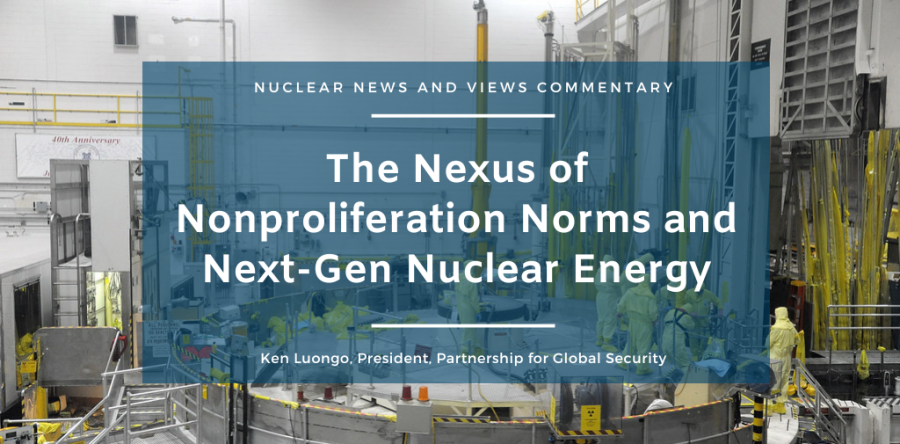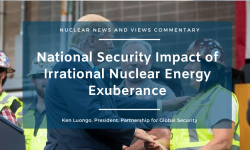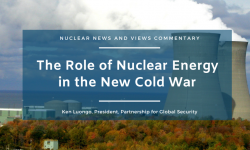There are many cross currents coursing through the development process for next-generation small nuclear reactors including funding, regulatory approval, and technology demonstration. But one issue receiving little attention is the relationship between these new reactors and the global non-proliferation system.
The challenges posed by the adaptation of international nuclear safeguards and security requirements to these reactors is one set of significant issues. But other nonproliferation norms are intersecting with this technology’s advancement.
One issue was recently highlighted in a letter from non-proliferation experts to the DoE and NNSA opposing the proposed use of highly-enriched uranium to fuel the Molten Chloride Reactor Experiment (MCRE) at Idaho National Laboratory. HEU is a nuclear-weapon usable material.
The MCRE is a very small fast spectrum reactor and the proposed experiment is being funded by the DoE Advanced Reactor Demonstration Program, Southern Company, and Terra Power. The reactor would produce about 200 kilowatts of energy, a minuscule output compared to typical nuclear power reactors. It would operate for a limited period and the purpose of the experiment is to “demonstrate the operation of molten fuel salts at temperatures” sufficient to prove performance, safety, and economic benefits of the fuel cycle when compared to conventional light-water reactors.
The problem, as described in the letter, is that the test would “use fuel containing more than 600kg of 93%-enriched, weapons-grade” uranium. This would violate U.S. government policy dating back to the Ford Administration to minimize the use of HEU in civil applications. It also would conflict with considerable U.S.-led work that has gone on for decades to convert research reactors around the world from HEU to low-enriched uranium which is not weapons-usable.
However, the difference between the 1970’s and the 2020’s is that the MCRE is being used to support advanced nuclear reactor technology that can be used to address climate change and achieve carbon reduction targets. This creates an uncomfortable face-off between “existential threats” - nuclear weapons vs. climate change – that currently is festering.
Another current example where nuclear proliferation policy and climate challenges intersect is in the Versatile Test Reactor (VTR). The VTR is another proposed test facility for irradiating advanced reactor components and qualifying fuels that would support the development of next-gen reactors. The Congress has been somewhat indecisive about the value to cost ratio of the VTR. But the only similar facilities exist outside the U.S., including in Russia.
The main non-proliferation concerns about the VTR are that its fuel would include plutonium and that it potentially could be configured as a plutonium breeder. Both issues pose a problem similar to the MCRE because it would conflict with the U.S. policy to minimize the use of weapon-usable materials in civil nuclear processes.
But VTR could use plutonium that has been declared excess to the U.S. nuclear stockpile under a now-suspended security agreement with Russia. This could aid arms control efforts by demonstrating the willingness to eliminate excess weapons grade materials.
However, this benefit may not be sufficient. Of the many options for the disposal of this excess 68 tons of plutonium, the most prominent was to mix it with uranium to produce power reactor fuel, a prior permutation of the VTR idea. The U.S. spent over $8 billion on this solution before abandoning it. And nonproliferation specialists opposed it.
A third example of nuclear nonproliferation and carbon reduction clashing is in the potential reprocessing of spent nuclear fuel for re-use in some next-gen reactors.
Oklo, an advanced reactor company, has a partnership with Argonne National Laboratory to commercialize technology that would recycle spent fuel with the goal of reducing the cost of creating new fuel for the company’s reactor. This pairing is backed by DoE.
Also, the Canadian company, Moltex, proposes to recycle CANDU spent fuel and this approach has been supported by its government. However, non-proliferation experts wrote to the Canadian government to express concern about their official support. The main concern is that “by backing spent-fuel reprocessing and plutonium extraction, the government of Canada will undermine the global nuclear weapons nonproliferation regime.” The authors asserted that “saving the world from climate disaster need not be in conflict with saving it from nuclear weapons.”
But these examples make clear that the issues of nonproliferation and carbon reduction using advanced nuclear technologies are increasingly coming into conflict. And that clash needs to be addressed in a sound and balanced manner that serves the needs of both issues.
There are several new factors that need to be considered in this context. One is the dramatic change that has occurred in the global nuclear market since the 1970s and with the nuclear programs of Russia and China. Another is that a large segment of the world, representing about 6.5 billion people, is now rebelling against the U.S.-dominated rules-based international order and looking beyond American policy positions, including on nuclear issues.
These geopolitical realities, along with the pressing need for reliable clean energy, erode the once effective argument that U.S. nonproliferation policy is a beacon that other nations will follow. That may have been true in the past, but the power of this position is being diminished. And the weak position of the U.S. (and its allies) in the global nuclear market further saps this influence.
Russia continues to dominate nuclear fuel and reactor exports, despite its horrendous attacks on civil nuclear facilities in Ukraine. And its generous financial and operating package for newcomer nuclear purchasers is unlikely to end.
China is poised to lap the U.S. in domestic reactors operation likely by mid-century. This will be viewed symbolically in developing economy states as a significant technological achievement by a nation that once struggled with the economic, energy, and population problems that they now face.
Also, both Russia and China are very active in developing for export small advanced nuclear reactors, some of which may use weapon-grade fuels. Both countries also are supportive of spent fuel reprocessing. And they collectively dwarf the U.S. and its democratic allies in energy and infrastructure engagement with the developing economy world. This sets the stage for reactor transfers from them to new countries that would ignore U.S. policy imperatives.
These realities require a change in strategy.
Pressing nuclear policy ideas primarily on North American and European governments is convenient but Russia and China are more likely to be the global reactor developers and exporters to new countries. To counteract their advantages, and the potential dangers, there needs to be much more intensive U.S. engagement with the wide swath of nations that are impacted by climate change and interested in small nuclear reactors.
Rethinking relationships and expanding engagement among estranged partners is also essential. The non-proliferation community, both governmental and civil society, is not well suited for evaluating the macro-level risks, conflicts, and tradeoffs required to balance nuclear non-proliferation and carbon reduction. Similarly, the next-gen nuclear reactor development and climate change communities are not well versed in evaluating nuclear proliferation and weapons dangers. These communities need to engage more and tussle less.
This situation also requires that the academic and institutional systems that produce subject experts also develop the multidisciplinary expertise and skill sets needed to cut across silos and support the effective management of an increasingly complex, messy, and integrated global environment.
Choosing nuclear weapons or climate change as the top global threat is a losing proposition. A conflict between the two is unnecessary and unsustainable. Both will remain global imperatives and that will require balancing risks and rewards. But the structure for adjudicating these tradeoffs is in its infancy.





